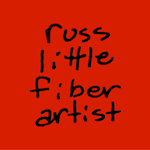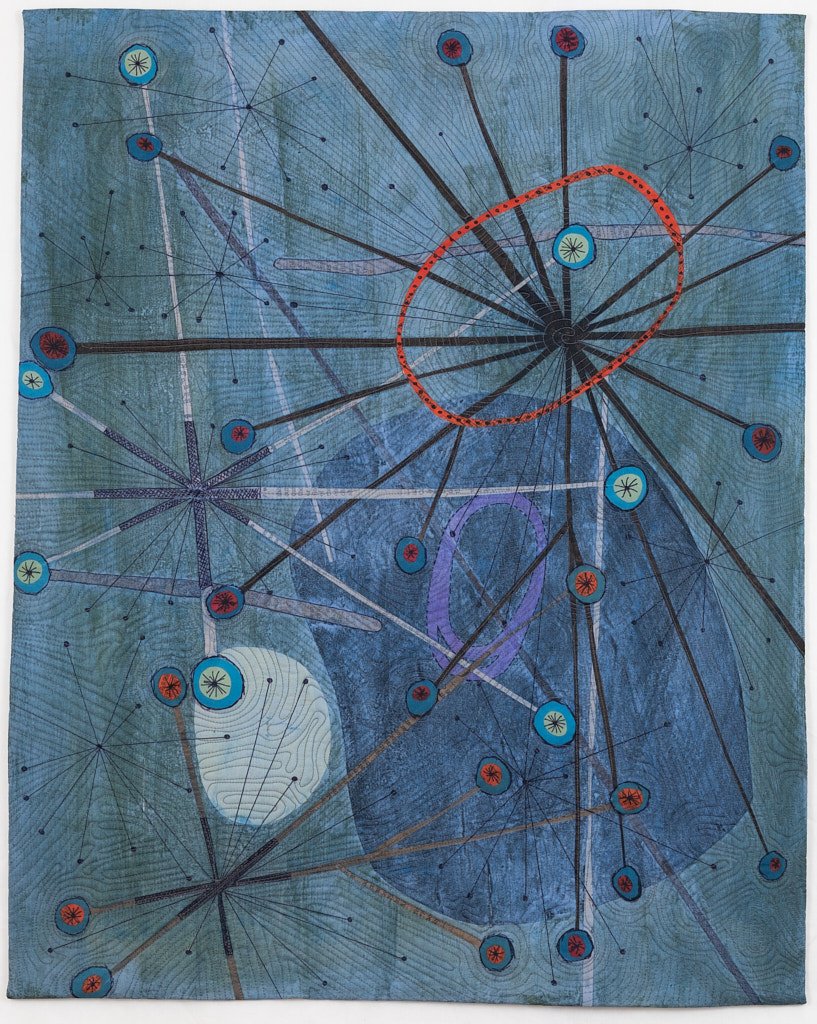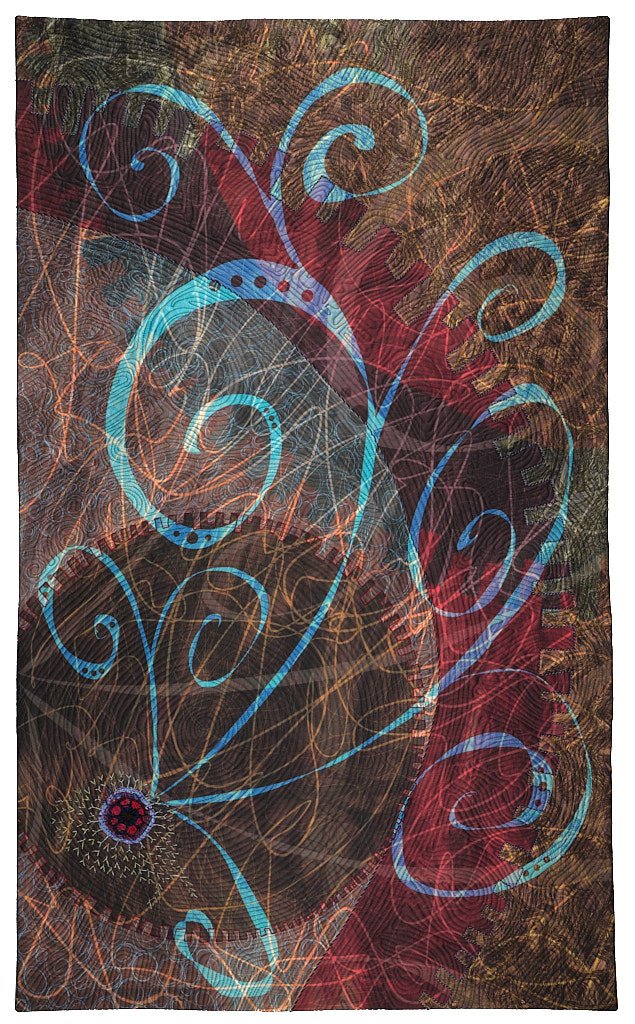Thoughts about the Outward Movement series
Outward Movement #1. 2018
Most of my artwork is created in a group or series of pieces that are related by content, purpose, or method. Working this way allows me to explore an idea over time and to refine my thinking. That isn’t to say that the earlier works in a series are somehow less than the later works, but looking at the group as a whole often reveals an evolution of thought. Sometimes I don’t even see that pattern of change myself until I’m well into the series or until I sit down to think and write critically about what I’m doing—like now.
I’m grateful to have completed several series, and to have several more still ongoing. The “completion” of a series is less a matter of reaching a predetermined goal of a number of pieces and much more about intuitively knowing that I have reached a point of completion. When the thought is complete, the mental itch has been adequately scratched, or I feel that the next piece is going to be forced simply for the sake of making “just one more” then it’s time to move on. I’ve recently decided that Outward Movement is finished, so this is a good time to capture my thoughts about this body of work. I’m hoping to do the same for my other completed series in the future.
Two subgroups
The seven pieces in the Outward Movement series were completed between 2018 and 2022. There are two distinct groups within the series:
The earlier, smaller pieces (1-3) measuring about 26 x 33 inches and the later pieces (4-7) measuring about 31 x 52 inches.
The first group all began their compositional lives as painting with collage elements on hardboard, while the second group are entirely digital compositions created on an iPad.
Why and how size might matter
Why the size change in the middle of the series? Gosh there are so many bad jokes to be made here about comparing size, but it really came down to a conversation that I had with a juror at an opening reception. She said something like, “I really like your piece, but it needs to be larger. It needs a ‘gallery presence’ that draws people to it from across the room.” Textile works of this sort— so called art quilts—tend to be large pieces. We’re talking in the range of 80 x 80 inches. That’s big, hard to store, difficult to ship, and when it comes to pricing they’re also much more expensive than smaller work. Also, show of hands, who has an empty wall in their house that doesn’t get direct sunlight, and can accommodate something that size? And yet, looking around that gallery I could see her point: my artwork looked out of scale, dwarfed by more monumental work. And thus, the size of 4-7 is both wider and taller but still within a size that could fit into someone’s home. I’ve now seen these larger-sized works in similar settings to that first show and I think that, while not being monumental themselves, they hold their place in the room better. Having said all of that I will observe that 1-3, the smaller pieces, have all been sold. So, do I size my artwork for the home or the gallery? It’s an open question, the answer to which I think might be to make some of each.
The ways I work
The first group is also different from the other in that these three pieces represent a combination of computer and manual techniques, and they all have a strong visual look that captures the hand drawing and painting, as seen below. I created 16 x 20 inch painted backgrounds on hardboard. On top of these I added painted paper shapes and lines and hand drawn elements to create the final composition, and these paintings exist as artworks undo themselves. Each finished painting was photographed, then the images were color corrected and printed on cloth using a wide carriage inkjet printer (by spoonflower.com). The printed fabric was stacked with acrylic felt batting and muslin backing then machine quilted.
Outward Movement #2
Outward Movement #3
Numbers 4 through 7 were created as paintings on an iPad using the Procreate app, which allows me to create layered drawings with shapes, fills, and a wide variety of line and brush marks using a stylus. These were among my first digital compositions. Number 4 is an all digital composition, but the highly textural background is derived from a photograph of a gelli plate monotype print with additional relief printed elements. With Procreate I was able to manipulate the image and add line and shape elements. By contrast, #7 is entirely digital. All of the background and foreground elements are created entirely in Procreate.
Outward Movement #4
Outward Movement #7
Hand stitching
Many of my pieces include some element of stitch beyond the obvious quilting lines. Sometimes the added stitch is created using an embroidery machine and other times by hand. In all cases the intent is to add detail and emphasize elements. On another more subtle level I also intend it to play off of, and contrast with, the regularity and sharpness that can come from computer-printing. The printer creates a far sharper line than I would by hand; the subtle or not-so-subtle irregularity of hand stitching can soften that sharpness.
Hand stitched details on Outward Movement #7
Quilting lines
For many years I’ve said that quilting lines are the final drawing element that I add to a quilted textile composition; it continues to be true. I quilt on a sit down long arm quilting machine. That means that the machine remains stationary while I move the quilt around freely under the needle. There are no feed dogs to move or guide the fabric. The quilting patterns are spontaneous. The only planning that goes into what I quilt is when I periodically stop, put the quilt on the design wall, and think about what might come next. There’s never any marking, templates, or rulers. The image below is a good example of much of my quilting. The quilting lines are reactions to the graphic elements, following the lines of the composition, but they also create new shapes that echo, emphasize, or stand in juxtaposition to the graphic elements and each other. The quilting lines are also an exercise in drawing with shadow. When the finished artwork is hung on a wall and lit from above, the texture created by the quilting catches the light, casting tiny shadows and bringing the surface to life.
Hand stitching and machine quilting lines on Outward Movement #6
Symbols and meaning
Circles
When I look at all 7 pieces in the series it is undeniable that circular forms are a key element. We all have shapes that speak to us. From some folks it’s squares; for others triangles. For me it’s circles, and they find their way in to most of my work in varying sizes.
The circle symbolizes a completed cycle, a center, wholeness, softness, enclosure,—perhaps even an embrace or protection.
Lines and paths
Lines can do several things in a composition: divide space, demarcate shapes, create connections, and establish flow. It’s impossible not to notice that the earlier pieces in the series emphasized straight lines, while the later pieces use many more curved lines. The curved lines more your eye through the piece differently than the straight lines. They also give the later pieces a more organic feel. The curling and branching lines feel vine-like, but also playful. Drawing these element felt like a playful act, and I think that feeling is instilled in the result.
Juxtaposition of angles and curves
Angular lines and sinuous lines are interesting on there own. Straight lines and sharp angles can evoke a feeling of the built environment, while curved one might feel more organic. Incorporating both angular and curving lines into the same composition can be an interesting way to depict the interaction between these two things—the built world and the natural. This is a recurring theme in my artwork and a design motif I use often.
Relative scale
Looking at the series in chronological order, I find it interesting that the circular elements become fewer and grow larger. In #7, about one third of the large gear-like circle covers most of the design space. I see this shift in scale as an opening up of the circle. As the circles get larger they begin to move more and more out of the design space. This feels like a natural expansion, like opening my arms from a tightly crossed posture. This expansion and outward movement wasn’t planned, and was only apparent to me after the later pieces were finished. And so, having grown the design elements right off the page, it feels that I’ve arrived at a fitting end point for the series.
Portfolio links
Timeline and history
| Title | Date | History |
|---|---|---|
| Outward movement #1 | 2018 |
Quilt National 2019, Dairy Barn Art Center, Athens, OH, May 25 – Sept 2, 2019 Quilt National 2019, Foundry Art Center, Saint Charles, MO, Oct 4 - Dec 6, 2019 Published in Quilt Naitonal 2019: The Best of Contemporary Quilts Sold in 2019 |
| Outward Movement #2 | 2019 |
Quilts=Art=Quilts 2019 Sold in 2019 |
| Outward Movement #3 | 2019 | Sold in 2021 |
| Outward Movement #4 | 2020 | Between the Lines, (Gayle Friedman & Russ Little) Portico Gallery, Brentwood, MD Nov 19, 2022 - Jan 14, 2023 |
| Outward Movement #5 | 2020 |
Published in Wide Open: An Exhibition by the Art Cloth Network Open Space, Cultural Activities Center, Temple, Texas, Nov - Dec, 2021 (a combined showing of ACN The Space Between and Wide Open) Open Space, Austin Bergstrom International Airport, Austin Texas, Zilker and Jollyville Galleries January - May, 2022 (a combined showing of ACN The Space Between and Wide Open) Between the Lines, (Gayle Friedman & Russ Little) Portico Gallery, Brentwood, MD Nov 19, 2022 - Jan 14, 2023 Wide Open, Bloomingdale Parks District Museum, Bloomingdale, IL June 8 - Aug 5, 2023 |
| Outward Movement #6 | 2020 |
Between the Lines, (Gayle Friedman & Russ Little) Portico Gallery, Brentwood, MD Nov 19, 2022 - Jan 14, 2023 |
| Outward Movement #7 | 2022 |
Between the Lines, (Gayle Friedman & Russ Little) Portico Gallery, Brentwood, MD Nov 19, 2022 - Jan 14, 2023 |














